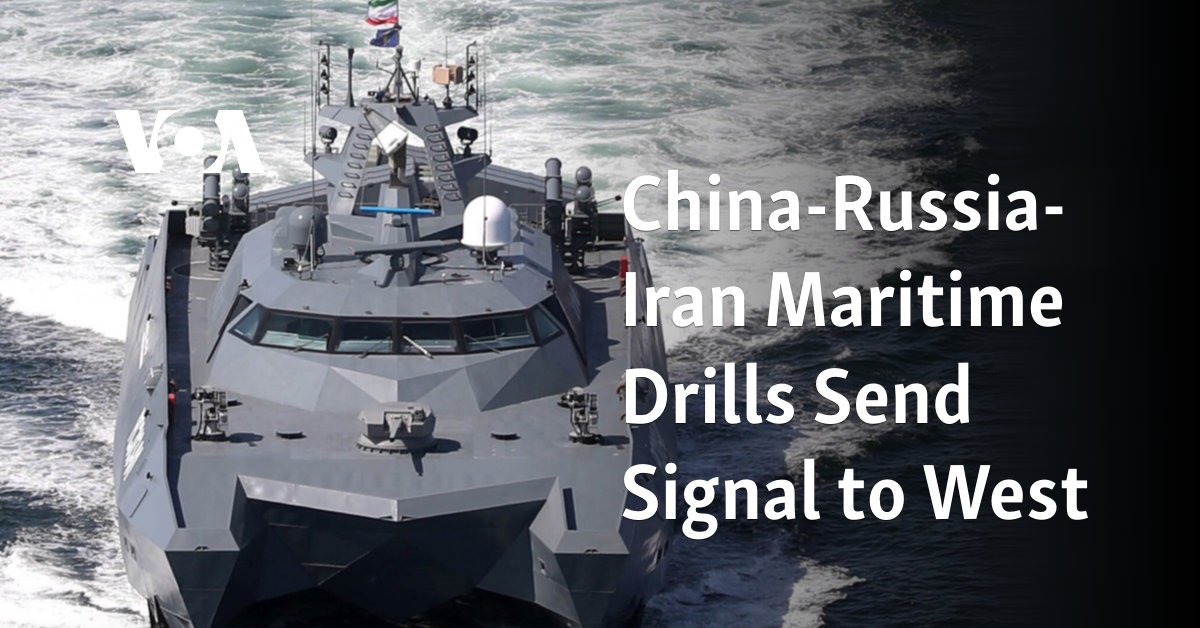China conducted joint military drills this week with Russia and Iran in the Gulf of Oman, a critical water conduit near the entry to the Persian Gulf.
The five-day exercise, “Maritime Security Belt 2024,” involved both naval and aviation forces, with the primary objective of enhancing the security of maritime economic activities, according to Russia’s Ministry of Defense.
The drills may have been planned long in advance of the current Israel-Hamas war, but their implication and message to regional players and the West are highly significant, analysts say.
More than 20 ships, combat boats, support carriers and navy helicopters participated in the exercise.
Iran’s semiofficial Mehr News Agency reported that Iran’s Islamic Revolutionary Guard Corps (IRGC) debuted new warships in the exercise, including the Shahid Soleimani corvette.
“That’s a game changer,” Wendell Minnick, an arms specialist and “China in Arms” podcaster, told VOA.
“Pay close attention to anti-ship missiles on ships,” Minnick said. “The U.S. Navy has a real problem with these types of missiles.”
The IRGC-operated Shahid Soleimani corvette is equipped with long- and short-range anti-ship cruise missiles. It’s the first Iranian warship outfitted with advanced VLS, or Vertical Launching Systems, for firing surface-to-surface and surface-to-air missiles.
“This gives the U.S. Navy a nightmare scenario of being saturated by multidirectional vectors of attack that they cannot possibly defeat en masse,” Minnick said. “Like being attacked by bees or ants. Eventually they will get you.”
Rear Admiral Mohammad Nozari, the IRGC commander of Iran’s base at Chabahar on the Gulf of Oman, told the Mehr News Agency the drill’s chief objectives were consolidating regional security, promoting China-Russia-Iran cooperation, and safeguarding global peace and maritime security.
Analysts say Chinese, Russian and Iranian objectives go far beyond the IRGC top naval commander’s stated claims.
“The Chinese and the Russians are using this exercise as a variety of tools disposable to them to show their presence and to pressure the West,” said Meir Javedanfar, who teaches Iranian security studies at Reichman University, in Herzliya, Israel.
“The Chinese are saying these exercises are normal and have nothing to do with what’s happening in the Middle East,” Javedanfar said in an interview with VOA.
“Nevertheless, the fact that these exercises are taking place against the background of an unprecedented U.S. and Western naval presence in the Middle East shows that the rivalry between the China-Russia-Iran front against the Western front is now heating up, and the Middle East waters are playing an important part in this rivalry.”
The rivalry takes on heightened significance when weighed against the recent uptick in Chinese participation in regional drills.
In November, China collaborated with Pakistan in “Sea Guardian 3” joint naval exercises in the Arabian Sea. It was the biggest joint People’s Liberation Army Navy (PLAN) and Pakistani Navy drill to date and included land and sea phases.
China’s warships are stationed at a naval base in Djibouti near the Red Sea waters where Iranian-backed Houthis declaring solidarity with Palestinians in the Israel-Hamas conflict have since last year repeatedly fired drones and missiles at ships. China has not publicly condemned the attacks.
“If China really wanted the Houthis to stop these attacks against Western shipping, they could pressure the Iranians and the Iranians would listen, but they’re not doing this because they want to pressure Western economies and to show that they have influence in the region,” Javedanfar said.
“The drills play a part in the larger strategy led by China and Russia and Iran,” Javedanfar said.
Sophie Kobzantsev, a Russia analyst and research fellow at the Misgav Institute in Jerusalem, says the Gulf of Oman drill is part strategy, part message.
“From the beginning — the Russia-Ukraine war — Russia’s goal was to create a new world order in which it gets a role or a place as super world power,” Kobzantsev told VOA.
“Part of this concept of the new world order is to partially create a military balance vis-a-vis the West. The drill serves Russia — and Iran and China — in creating the image and the message to the West that there is a counterstrategic military coalition.”
Leading the Russian contingent was the missile cruiser Varyag from its Pacific Fleet, according to the Russian Ministry of Defense. Naval representatives from Pakistan, Kazakhstan, Azerbaijan, Oman, India and South Africa served as observers during the exercises.
The drills come just a week after NATO’s Nordic Response exercises, the most expansive NATO drills since the Cold War ended in 1991. Nordic Response incorporated military participation of NATO’s newest member states Sweden and Finland.
With an increased U.S. foothold in the Middle East due to its role in mediating the Israel-Gulf States Abraham Accords, pursuing the normalization of Israel-Saudi ties and now mediating between Israel and Hamas, the drill also takes on “countermessage” significance, said Kobzantsev.
The area where the joint drills are taking place is also significant. An estimated 20% of globally traded oil moves through the narrow Strait of Hormuz passage linking the Persian Gulf and the Gulf of Oman.
Since 2019 the Gulf of Oman has seen a series of ship seizures and attacks that the U.S. has blamed on Iran, although Tehran has denied any involvement.
“We actually see a kind of formation of the world that is reminding us of the Cold War and that there is a new clash between superpowers in this world,” said Kobzantsev. “The West vs. Russia, China and Iran.”
Marine Security Belt 2024 is the fourth joint China-Russia-Iran military exercise since 2019.
Adrianna Zhang contributed to this report.


